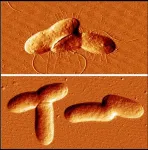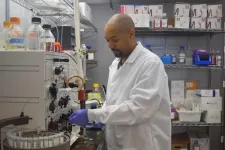(Press-News.org) East Hanover, NJ – January 10, 2025 – The employment-to-population ratio for people with disabilities has remained stable over the past 15 months amid historically high levels, with recent data suggesting a modest but encouraging upward trend, according to today’s January 2025 National Trends in Disability Employment monthly update (nTIDE) issued by Kessler Foundation and the University of New Hampshire’s Institute on Disability (UNH-IOD).
Month-to-Month nTIDE Numbers (comparing November 2024 to December 2024)
Based on data from the U.S. Bureau of Labor Statistics (BLS) Jobs Report released today, the employment-to-population ratio for people with disabilities (ages 16-64) slightly increased from 38 percent in November 2024 to 38.1 percent in December 2024 (up 0.3 percent or 0.1 percentage points). For people without disabilities (ages 16-64), the employment-to-population ratio stayed the same at 74.9 percent in November 2024 and December 2024. The employment-to-population ratio, a key indicator, reflects the percentage of people who are working relative to the total population (the number of people working divided by the number of people in the total population multiplied by 100).
“The employment-to-population ratio for people with disabilities has remained relatively stable over the past 15 months, fluctuating between 36.4 percent and a high of 38.3 percent,” remarked John O’Neill, PhD, director of the Center for Employment and Disability Research at Kessler Foundation. “Despite these fluctuations, the current levels remain historically high, and the overall trend resembles more of a sawtooth than a clear rise or fall.” Dr. O’Neill added, “This plateau in the employment rate for people with disabilities could reflect hesitation among employers to alter hiring practices until the new national leadership is in place.”
“Nevertheless, if you examine the data closely month by month, it is encouraging,” explains Hyun Jun Kim, PhD, Project Director III at UNH-IOD. “Historically, we don’t typically see significant ups and downs in December. What we’re seeing now is a trajectory of gradual increase, and even though it’s a small rise, it’s still progress. I hope to see that continue next month.”
Meanwhile, the labor force participation rate for people with disabilities slightly increased from 41.1 percent in November 2024 to 41.3 percent in December 2024 (up 0.5 percent or 0.2 percentage points). For people without disabilities, the labor force participation rate slightly decreased from 77.9 percent in November 2024 to 77.7 percent in December 2024 (down 0.3 percent or 0.2 percentage points). The labor force participation rate is the percentage of the population that is working or actively looking for work (the number of people in the labor force divided by the number of people in the total population multiplied by 100).
Year-to-Year nTIDE Numbers (comparing December 2023 to December 2024)
When compared to the same month last year, the employment-to-population ratio for people with disabilities increased from 37.9 percent in December 2023 to 38.1 percent in December 2024 (up 0.5 percent or 0.2 percentage points). For people without disabilities, the employment-to-population ratio also increased from 74.6 percent in December 2023 to 74.9 percent in December 2024 (up 0.4 percent or 0.3 percentage points).
The labor force participation rate for people with disabilities increased from 40.8 percent in December 2023 to 41.3 percent in December 2024 (up 1.2 percent or 0.5 percentage points). For people without disabilities, the labor force participation rate slightly increased from 77.3 percent in December 2023 to 77.7 percent in December 2024 (up 0.5 percent or 0.4 percentage points).
In December, 6,658,000 workers with disabilities (ages 16-64) represented 4.4 percent of the total U.S. workforce of 150,074,000.
Ask Questions about Disability and Employment
On January 10, 2025, at 12:00 pm – 1:00 pm Eastern, guest presenter Bill Field, project director of AgrAbility and a professor of agricultural & biology engineering at Purdue University, joined Drs. Kim, O’Neill, and Denise Rozell, Director of Policy Innovation, AUCD. Attend our next free Lunch & Learn on February 7, 2025, or visit the nTIDE archives at ResearchonDisability.org/nTIDE.
About nTIDE Updates
National Trends in Disability Employment (nTIDE) is a joint project of Kessler Foundation and the University of New Hampshire Institute on Disability. The nTIDE team closely monitors the job numbers, issuing monthly reports that track the impact of economic shifts on employment for people with and without disabilities. The statistics in the nTIDE are based on BLS numbers but are not identical. They are customized by UNH to combine the statistics for men and women of working age (16- 64). nTIDE is funded by the National Institute on Disability, Independent Living and Rehabilitation Research (NIDILRR; 90RTGE0005) and Kessler Foundation. Each nTIDE release is followed by an nTIDE Lunch & Learn online webinar. This live broadcast, hosted via Zoom Webinar, offers attendees Q&A on the latest nTIDE findings, provides news, updates from the field, and features invited panelists who discuss current disability-related findings and events.
About the Institute on Disability at the University of New Hampshire
The Institute on Disability at the University of New Hampshire was established in 1987 to provide a university-based focus for the improvement of knowledge, policies, and practices related to the lives of persons with disabilities and their families. For information on the Institute’s NIDILRR-funded Rehabilitation Research and Training Center on Disability Statistics and Demographics (StatsRRTC), visit ResearchOnDisability.org.
About Kessler Foundation
Kessler Foundation, a major nonprofit organization in the field of disability, is a global leader in rehabilitation research. Our scientists seek to improve cognition, mobility, and long-term outcomes, including employment, for adults and children with neurological and developmental disabilities of the brain and spinal cord including traumatic brain injury, spinal cord injury, stroke, multiple sclerosis, and autism. Kessler Foundation also leads the nation in funding innovative programs that expand opportunities for employment for people with disabilities. Visit KesslerFoundation.org.
For more information, contact:
Deb Hauss, DHauss@KesslerFoundation.org
END
nTIDE January 2025 Jobs Report: Encouraging signs in disability employment: A slow but positive trajectory
National Trends in Disability Employment (nTIDE) – Issued monthly by Kessler Foundation and the University of New Hampshire
2025-01-10
ELSE PRESS RELEASES FROM THIS DATE:
Generative AI: Uncovering its environmental and social costs
2025-01-10
A recent commentary article by researchers from Northwestern University, Harvard University, and The University of Texas at San Antonio highlights the significant but overlooked environmental and social impacts of Generative Artificial Intelligence (GenAI). Published in Environmental Science and Ecotechnology, the research underscores the urgent need for sustainable practices and ethical governance as GenAI technologies proliferate.
The study reveals the environmental toll of GenAI development, with hardware production such as GPUs and data centers consuming ...
Lower access to air conditioning may increase need for emergency care for wildfire smoke exposure
2025-01-10
FOR IMMEDIATE RELEASE
January 10, 2025
Contact:
Jillian McKoy, jpmckoy@bu.edu
Michael Saunders, msaunder@bu.edu
##
Lower Access to Air Conditioning May Increase Need for Emergency Care for Wildfire Smoke Exposure
As Los Angeles County battles the most destructive wildfires in its history, a new study suggest that US policies should prioritize equity and education regarding the measures people can take to protect themselves from the harmful pollutants in wildfire smoke.
People who have limited access to air ...
Dangerous bacterial biofilms have a natural enemy
2025-01-10
If your teeth have ever felt fuzzy after skipping a brushing, you’ve encountered biofilm—a slimy bacterial layer that clings to surfaces. In medical settings, biofilms make infections harder to treat when they form protective shields for bacteria on devices like catheters and implants.
UC Riverside scientists have now discovered a chemical that plants produce when they're stressed prevents biofilm from forming. The breakthrough offers potential advances in healthcare as well as preventing equipment corrosion in industrial settings.
“In simple terms, biofilms are communities ...
Food study launched examining bone health of women 60 years and older
2025-01-10
Hinda and Arthur Marcus Institute for Aging Research investigators at Hebrew SeniorLife have launched a large clinical food trial to test whether a combination of probiotics and prebiotics (BondiaÒ or SBD111) developed by Solarea Bio will help manage bone health in women aged 60 years and above. The first participants have joined the study and the Institute seeks additional women for the 18-month effort.
“I am very happy to be involved in this important research to help with bone health in women,” says study participant Kathy ...
CDC awards $1.25M to engineers retooling mine production and safety
2025-01-10
From mapping ore to predicting slope behavior and reclaiming land, mining is a rapidly evolving technological industry. Yet planning and operations have not necessarily kept up with the advancements.
With $1.25 million from the National Institute for Occupational Safety and Health, or NIOSH, mining and geological engineering researchers in the University of Arizona College of Engineering are boosting their efforts to better align technology and planning for improved safety and productivity.
The award from the institute, part of the Centers for Disease Control and Prevention, will fund the research ...
Using AI to uncover hospital patients’ long COVID care needs
2025-01-10
PHILADELPHIA— Across the United States, no hospital is the same. Equipment, staffing, technical capabilities, and patient populations can all differ. So, while the profiles developed for people with common conditions may seem universal, the reality is that there are nuances that require individual attention, both in the make-up of the patients being seen and the situations of the hospitals providing their care.
New research shows that artificial intelligence can potentially help improve care overall by combing through ...
$1.9M NIH grant will allow researchers to explore how copper kills bacteria
2025-01-10
TUCSON, Arizona — A researcher at the University of Arizona College of Medicine – Tucson received a $1.9 million grant from the National Institutes of Health to continue his research into uncovering the mysteries of copper – specifically, how it can be harnessed to kill harmful bacteria and other microorganisms.
“We started using copper tens of thousands of years ago to cut down on bacterial infections,” said Michael D.L. Johnson, PhD, an associate professor ...
New fossil discovery sheds light on the early evolution of animal nervous systems
2025-01-10
Embargoed until Friday 10-Jan-2025 14:00 ET (10-Jan-2025 19:00 GMT/UTC)
An international team of scientists has uncovered a fascinating piece of the evolutionary puzzle: how the ventral nerve cord, a key component of the central nervous system, evolved in ecdysozoan animals, a group that includes insects, nematodes, and priapulid worms. Their findings, published in Science Advances, provide valuable insights into the origins of these structures in the basal Cambrian period.
The research team, comprising Dr Deng Wang (Northwest University), Dr Jean Vannier (Université ...
A battle of rafts: How molecular dynamics in CAR T cells explain their cancer-killing behavior
2025-01-10
HOUSTON – (Jan. 10, 2025) – A study published in Science Advances shares new insights into how two of the most common types of chimeric antigen receptor (CAR) T cells kill cancer. Investigators from Baylor College of Medicine, Texas Children’s Cancer Center and the Center for Cell and Gene Therapy at Baylor, Houston Methodist Hospital and Texas Children’s Hospital examined how molecular dynamics at the immune synapse – where CAR T cells bind to cancer cells – affect anticancer activity.
In this study, researchers aimed to understand how CAR T cells with different signaling domains work at the molecular and cellular levels to lay the ...
Study shows how plant roots access deeper soils in search of water
2025-01-10
Scientists have discovered how plants adapt their root systems in drought conditions to grow steeper into the soil to access deeper water reserves.
Plant scientists from the University of Nottingham, in collaboration with Shanghai Jiao Tong University, have identified how abscisic acid (ABA), a plant hormone known for its role in drought response, influences root growth angles in cereal crops such as rice and maize. The results have been published in Current Biology.
The study highlights how ABA and auxin, another key hormone, work together to shape root growth ...
LAST 30 PRESS RELEASES:
A decline in churchgoing linked to more deaths of despair
TAMEST announces Maralice Conacci-Sorrell, Ph.D., UT Southwestern Medical Center, as 2026 Mary Beth Maddox Award & Lectureship Recipient
Global study to evaluate whether dengue outbreaks can be anticipated earlier
Chonnam National University researchers propose innovative voltage-loop control for power factor correction
Accelerating next-generation drug discovery with click-based construction of PROTACs
Detecting the hidden magnetism of altermagnets
$7M gift supports health research, engineering and athletics at UT San Antonio
NU-9 halts Alzheimer’s disease in animal model before symptoms begin
Hospitals acquired by real estate investment trusts associated with greater risk of bankruptcy, closure
City of Hope scientists study rare disorder to uncover mechanism and hormone regulation underlying fatty liver disease and sweet aversion
Your genes may influence gut microbiome of others, rat study shows
‘Personality test’ shows how AI chatbots mimic human traits – and how they can be manipulated
Global food systems driving twin crises of obesity and global heating
Osaka Medical and Pharmaceutical University researchers capture real-time molecular movies of enzyme catalysis
Could your genes influence the gut microbiome of others?
Clues to Alzheimer’s disease may be hiding in our ‘junk’ DNA
Study reveals that the body uses different sensors to detect cold in the skin and in internal organs
iPS cells from dish to freezer and back
Deep neural networks enable accurate pricing of American options under stochastic volatility
Collective risk resonance in Chinese stock sectors uncovered through higher-order network analysis
Does CPU impact systemic risk contributions of Chinese sectors? Evidence from mixed frequency methods with asymmetric tail long memory
General intelligence framework to predict virus adaptation based on a genome language model
Antibiotic resistance is ancient, ecological, and deeply connected to human activity, new review shows
Vapes, pouches, heated tobacco, shisha, cigarettes: nicotine in all forms is toxic to the heart and blood vessels
From powder to planet: University of Modena engineers forge a low-carbon future for advanced metal manufacturing
Super strain-resistant superconductors
Pre-school health programme does not improve children’s diet or physical activity, prompting call for policy changes, study finds
Autumn clock change linked to reduction in certain health conditions
AI images of doctors can exaggerate and reinforce existing stereotypes
Where medicine meets melody – how lullabies help babies and parents in intensive care
[Press-News.org] nTIDE January 2025 Jobs Report: Encouraging signs in disability employment: A slow but positive trajectoryNational Trends in Disability Employment (nTIDE) – Issued monthly by Kessler Foundation and the University of New Hampshire




